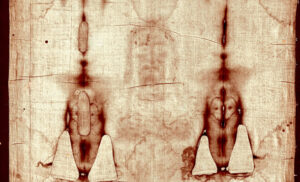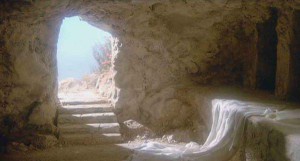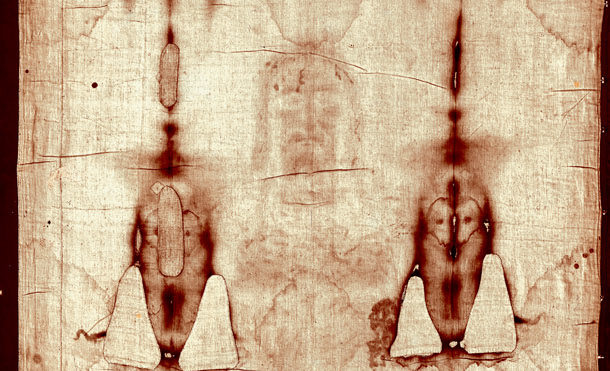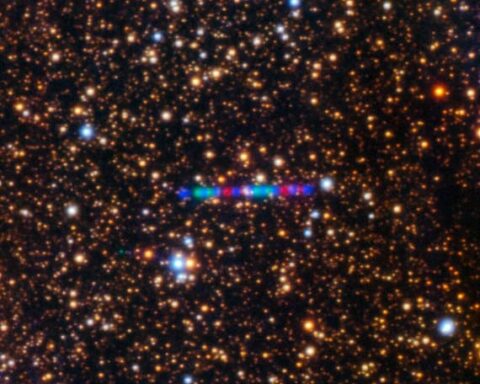You might’ve heard announcements this week that the mysterious Shroud of Turin has apparently been successfully dated to the time of Jesus.
I hope his thoughts are as engaging and thought-provoking to some of you as they are to me…
The Shroud of Turin: The Ultimate Easter Egg?
By guest writer quill.i.am
There must be a reason why so many of us are drawn to the enigmatic faces proffered occasionally by our unfathomable universe. By peering deeply into their eyes, answers to age-old mysteries may reveal themselves, even if only fleetingly.
The Face on Mars was one, a peculiar rock formation in the red planet’s Cydonia region that had us pondering the possibility of an ancient Martian civilisation. The spell was eventually broken, as new high-resolution images of the region emerged, revealing it had all been a trick of the light.
Another enigmatic face was on the cover of Whitley Striebers’ 1987 book, Communion: a compelling and, for a short while, ubiquitous alien face, with haunting, black, almond eyes. It’s debatable whether Striebers’ work was fully a work of non-fiction but there’s no argument over the book cover’s impact on popular culture.
But for me, the king of enigmatic faces was – and remains – the Face on the Shroud.
I refer to the Shroud of Turin, which many believe to be the burial cloth of Jesus of Nazareth, bearing the faint image of a man. Believers claim this image was created by energy radiating from Jesus’s body, at the time of the resurrection.
I was barely a teen when I first set eyes on that majestic, penetrating face. The venerated cloth had featured on some television programme. I was immediately transfixed. The expression conveyed a reassuring, all knowing serenity.

I later discovered that I had been looking at a photographic negative, and the enigma deepened. With lights and darks unreversed, the image on the Shroud is nowhere near as impressive.
Real or fake, only those of us living in more modern times – post the invention of photography – have been blessed to fully appreciate the Face on the Shroud.
Soon after, I watched the 1978 documentary The Silent Witness, persuasively narrated by English actor Kenneth More. As Shroud documentaries go The Silent Witness remains definitive and well worth watching as an introduction to the Face on the Shroud enigma.
And so began a lifelong fascination in the most studied and debated religious artefact in history. I’d go to the local library to borrow and devour each new Shroud book, shedding more light on this centuries old mystery.
I’d share Shroud revelations with my mother and grandmother, who were always fascinated to learn more. I recall my grandmother, in particular, eager for details. Only now do I realise how much comfort this must have been for her, in her advancing years. I was presenting compelling evidence for the Shroud’s authenticity and, by implication, the resurrection and a promise of eternal life.
Now I don’t propose to present in detail this Shroud evidence as it can easily be accessed from the countless presentations and documentaries that have followed in the wake of The Silent Witness. But here’s a brief summary of the main arguments for authenticity.
Pollen: researchers claim to have identified pollen grains on the Shroud, unique to the Jerusalem area that date back to the 1st century.
Bloodstains and wounds: those depicted on the Shroud – on the wrists, feet, side and head – align with the injuries inflicted on the crucified Jesus as described in the Gospels.
3D information: as well being a photographic negative, the image on the Shroud can be decoded by modern technology to create a 3D representation of the body, suggesting the image could not have been painted but rather created by a unique and as yet unknown process.
The Sudarium of Oviedo: this cloth’s historicity can be traced to as early as 570 AD. It is believed to have covered Jesus’s face, with bloodstains that seemingly match those on the Shroud. Evidence, perhaps, that both cloths covered the same body and are both authentic.
History: while the historicity of the Shroud prior to the 14th century is speculative, there are plausible theories tracing the cloth all the way back to the 1st century. Some claim the Shroud is the ancient Image of Edessa (a city in Asia Minor) gifted by one of Jesus’s disciples to Edessa’s ruler, King Abgar, following the crucifixion.
Emerging in the 6th century and later venerated by the Byzantines, the cloth disappeared following the sacking of Constantinople, during the Fourth Crusade, after which it was taken to Europe, eventually to surface in France.
Some art historians claim that the portrayal of a bearded Jesus in iconography, which became widespread by the 6th century, may have been inspired by the Face on the Shroud. Prior to this, Jesus had always been depicted as clean shaven.
Sceptics, of course, dissect and counter all these claims with convincing counter-claims of their own.
The main and, sceptics would argue, killer contention against Shroud’s authenticity is the radiocarbon tests of 1988, performed on a sample of the Shroud by laboratories in Oxford, Zurich and Tucson.
These tests dated the cloth to between 1260 and 1390 AD, strongly suggesting it is a medieval fake rather than a 1st-century relic.
This bombshell threw proponents of the Shroud’s authenticity into a tailspin. They have since made strenuous, though not entirely convincing efforts to negate the results of the radiocarbon tests. They argue that the Shroud test samples were either contaminated or non-representative, that the methodology of the tests were suspect due to inadequate cleaning of the samples.
Some Shroud proponents even claim that those conducting the tests were biased against the Shroud’s authenticity or were pressured to influence their results.
Now, in August 2024, there’s another twist in the Face on the Shroud enigma. Scientists in Italy, using a dating process involving something called ‘wide-angle X-ray scattering’, have determined that the cloth is a 2,000-year-old relic after all.
No doubt the sceptics will counter this latest revelation, pointing out plausible flaws, discrepancies, even unconscious bias by Christian apologists. And consensus, inevitably, will remain unreachable.
And all this will leave us laypeople where we have always been: manipulated mortals, left to make up our own minds based – ultimately – on whether we want to believe or not.
Yes folks: in the final analysis, matters of faith always boil down to… faith.
Unless, perhaps, there’s another way to look at this enigma, rejecting both the opposing world views, whether proponent or sceptic. Instead, what if we peered deeply into the eyes of the Face on the Shroud for alternative answers? Age-old mysteries about our unfathomable universe may reveal themselves, even if only fleetingly.
Buckle up. What if the Shroud of Turin was an Easter egg?

The ultimate Easter egg?
The theory that all of reality is an artificial simulation, created by some advanced intelligence, is gaining greater traction, in both philosophical and scientific contexts, and permeating into popular culture. This is due, in part, to ever increasing computer power that results in ever more sophisticated and immersive computer games.
Compare the first Tennis for Two game of the late 70s to the mind-blowing worlds now being created for games like Grand Theft Auto. Now project forward and imagine what fully-immersive virtual realities may be possible in 50 years hence – or 500 years!
It seems inevitable that virtual reality will one day be indistinguishable from (what we perceive as) base reality.
But what if such a simulated universe had already been created, and that’s what we are inhabiting already?
The secret messages that programmers intentionally hide in video games for attentive players to discover are called ‘Easter eggs’: the term was coined by an Atari manager who thought these hidden surprises in games reminded him of “waking up on Easter morning and hunting for Easter eggs.”
What if the hypothetical creator of our simulated universe has introduced certain anomalies within it – Easter eggs – as deliberately hidden messages or clues for mortals like us to discover and ponder over?
The precise method by which the image on the Shroud was imprinted on the cloth remains a mystery, pushing the boundaries of scientific inquiry, art history and theology. In a simulated universe, this could be seen as an intentional puzzle, left by the creator, to provoke curiosity and debate.
The Shroud is deeply tied to the Christian narrative. It’s an artefact seemingly designed to test, even shape our belief systems, influencing cultural and religious development. The Shroud’s ability to evoke such strong emotional and spiritual responses could be viewed as an intentional design choice, embedding deeper significance within the simulation to enhance our experience.
Some aspects of the Shroud, like the 3D information encoded in the image, defy scientific explanation and could be interpreted as signs of a constructed reality, where certain phenomena have been introduced by design to elude us and hint at the artificial nature of our universe.
Radiocarbon dating suggests the Shroud is from the Middle Ages and therefore a fake. Now X-ray dating contends that the cloth is indeed from the 1st century and therefore a real relic.
What if such discrepancies were deliberate ‘glitches in the Matrix’, anachronisms introduced by the creator to spark debate about the Shroud’s authenticity and, by extension, the true meaning of the simulation?
The concept of Resurrection itself might be a puzzle planted by the simulation’s creator, with the Shroud serving as a tangible representation, a calculated challenge placed within the simulation, encouraging us to question, explore and investigate our reality more deeply.
Isn’t that the hallmark of a great Easter egg?
Ok, you’ve probably had your fill of Easter eggs for now so here’s a final thought to bring us back to reality.
My mother is in a care home now and, with her cancer now spreading, probably doesn’t have long to go. When I visited her recently, on her 93rd birthday, I made a point of mentioning the new X-ray dating, confirming the Shroud was 2,000 years old and, therefore, authentic after all.
I suggested this might be a sign. Jesus had been thinking of her on her birthday, and was preparing to receive her, when she was ready to join him in heaven.
My mother’s eyes lit up. She was contented and reassured.
What better explanation for the Shroud’s purpose than that?
My thanks to quill.i.am for this article.





This site is on WordPress, right? You should be able to create accounts for your guest author, so that when they want to submit stuff, they’d at least show up on the website as the original author. Plus, they’d surely get a kick out of filling out their own profile n’stuff. Clearly this platform of yours is growing in a positive way!
Thank you, quill.i.am, these are compelling thoughts. I don’t think I’ve seen the mystery of the shroud discussed in terms of simulation theory anywhere else.
I love the idea of it. And it’s an idea I’ve contemplated before, though not specifically in reference to the Shroud of Turin. But I love the thought of Easter eggs being scattered around our reality on purpose.
In terms of the shroud itself, I doubt any finding will ever be regarded as conclusive, at least not universally. The opposing interests, with opposing ideological motivations, won’t come to terms.
I suppose the announcements about the reliable dating to the 1st century – combined with previous findings concerning traces of elements linking it to the correct environment in the Middle East – are validating to a lot of people.
Which is kind of exciting, as such things rarely pan out that way.
I liked the theory that the shroud was a master forgery by Leonardo Da Vinci: but I never quite believed that – just enjoyed it as an idea.
But in terms of the miraculous element, and the notion of an energetic based impression being made on the fabric, it’s never seemed that strange to me. Even though I’m not personally sure of the reality of the Resurrection in the religious sense (there are other, less miraculous schools of thought regarding what the Gospel writers might’ve been depicting: and I’ve tended to lean that way), the idea that a traumatised Jesus figure could imprint his image on the burial cloth always seemed entirely plausible to me.
For example, there are various parapsychological phenomena – such as ‘Thoughtography’, psychic photography, or even psychometry – that suggest an ability to psychically imprint images or impressions onto material objects under certain conditions.
In the case of psychometry, it’s more a case of objects retaining or containing certain psychic or energetic impressions that can be picked up on by sensitive minds.
Not to mention stuff to do with energy fields and aura-based photography.
I know some of this stuff is considered speculative science: but there’s enough evidence that we don’t fully understand how these things work.
And Jesus, we would have to consider, might’ve been a particularly psychic or clairvoyant type of person, with an especially interesting type of personal energy. The idea then that such a figure could create a psychic or energetic impression of himself onto the fabric – either deliberately or by accident – doesn’t seem far fetched.
I’m still bewitched by even the idea of basic photography itself – which we all take for granted: but the notion that you permanently capture a moment in time via a device that basically interprets light and then a chemical process that renders it into a physical item… Well, that’s always seemed like black magic and nonsense to me! But we just take it for granted.
And this is just approaching the subject as a matter of science. Approaching it as a subject of faith is, as you meaningfully highlight in the article, a whole other thing.
I guess actually you can expand that to all matters of faith or religion: what meaning or purpose someone personally takes from something versus what the technical or scientific considerations might or might now ‘allow’.
I had honestly never thought about the Turin Shroud in the context of anyone’s personal faith or as a thing that someone takes comfort in – until you just explained it that way. I suppose I’ve always been more tied up in the technical considerations.
But I actually take comparable comfort in the idea of the Easter eggs, the shroud – and perhaps the entire Jesus mystery – included.
Because I love mysteries, even if they remain unresolved. It’s a bit of a cliche, but the idea that we’re not ‘meant to’ figure it all out, but that it’s the constant quest for understanding that’s part of the meaning of life, has always appealed to me.
It’s always seemed to me that there’s something inherently beautiful in mystery and in contemplation of mystery… as opposed to simply determining an answer, writing it down and then sticking it in a corner to gather dust.
And I like the thought that ‘someone’ or something deliberately left us these anomalies to keep us thinking, keep us probing, and impart to us some underlying intuition that the nature of reality and our lives is much more interesting and less mundane than everyday life might trick us into otherwise believing.
So much food for thought. I could ramble about this forever.
But thank you: your re-contextualising of the subject of the shroud in terms of Easter egg programming is much more interesting than arguments about carbon dating or historical accuracy.